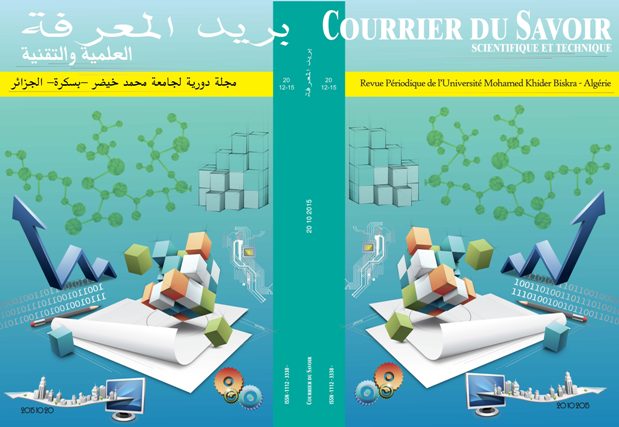EFFECTS STUDY OF SOLID PROTUBERANCES PROPERTIES ON THE TURBULENT NATURAL CONVECTION PERFORMANCE INSIDE A VERTICAL CHANNEL
Résumé
Dans cette étude, nous présentons des prédictions numériques des effets des propriétés géométriques, physiques et thermiques des protubérances, telles que la conductivité thermique des protubérances solides, les rapports d’aspect et les intensités du flux de chaleur exercées sur les faces externes des protubérances, sur la convection naturelle turbulente dans un canal vertical. Les résultats de l’analyse du transfert de chaleur sont obtenus en solutionnant les équations de l’écoulement de chaleur et des fluides en utilisant le modèle de la turbulence. Le système étudié est bidimensionnel, turbulent et permanant. La procédure numérique étend sur un code numérique qui modélise l’écoulement de chaleur et des fluides. Les résultats sont données en termes des champs et des profils des propriétés locales telles que la température, la vitesse, le coefficient de transfert de chaleur et l’intensité de la turbulence pour différents valeurs du rapport d’aspect des protubérances, la conductivité thermique et le flux de chaleur exercé sur les faces externes des protubérances. Les champs des propriétés d’air physiques et thermiques montrent des comportements différents en fonction de la valeur du rapport d’aspect des protubérances. Un effet positif sur le rendement de la convection naturelle turbulente a été prédit, dans la plage de 0 à 6,5%, par rapport à un canal vertical sans protubérances '. La présence des protubérances c’est un facteur important dans l’amélioration du rendement de la convection naturelle turbulente dans un canal vertical.
Références
[2] Assunta Andreozzi, Antonio Auletta, Oronzio Manca, Entropy generation in natural convection in a symmetrically and uniformly heated vertical channel, International Journal of Heat and Mass Transfer 49 (2006) 3221–3228.
[3] Young TJ, Vafai K., Convective cooling of a heated obstacle in a channel. Int. J. Heat Mass Transfer 1998 (41) 3131–48.
[4] Young TJ, Vafai K., Convective flow and heat transfer in a channel containing multiple heated obstacles. Int. J. Heat Mass Transfer 1998 (41) 3279–98.
[5] Leung CW, Chen S, Chan TL. Numerical simulation of laminar forced convection in an air-cooled horizontal printed circuit board assembly. Numer. Heat Transfer Part A 2000 (37) 373–93.
[6] Herman C, Kang E. Experimental visualisation of temperature fields and study of heat transfer enhancement in oscillatory flow in a grooved channel. Heat Mass Transfer 2001 (37) 87–99.
[7] Korichi A, Oufer L. Numerical heat transfer in a rectangular channel with mounted obstacles on upper and lower walls. Int. J. Therm. Sci. 2005 (44) 644–55.
[8] Moon JW, Kim SY, Cho HH. Frequency-dependent heat transfer enhancement from rectangular heated block array in a pulsating channel flow. Int. J. Heat Mass Transfer 2005 (48) 4904–13.
[9] Chen S, Liu Y, Chan SF, Leung CW, Chan TL. Experimental study of optimum spacing problem in the cooling of simulated electronic package. Heat Mass Transfer 2001 (37) 251–7.
[10] Chen S, Liu Y. An optimum spacing problem for three-by-three heated elements mounted on a substrate. Heat Mass Transfer 2002 (39) 3–9.
[11] Najam M, El Alami M, Oubarra A. Heat transfer in a ‘‘T” form cavity with heated rectangular blocks submitted to a vertical jet: the block gap effect on multiple solutions. Energy Convers Manage 2004 (45) 113–125.
[12] Baskaya S, Erturhan U, Sivrioglu M. Experimental investigation of mixed convection from an array of discrete heat sources at the bottom of a horizontal channel. Heat Mass Transfer 2005 (42) 56–63.
[13] Dogan A, Sivrioglu M, Baskaya S. Experimental investigation of mixed convection heat transfer in a rectangular channel with discrete heat sources at the top and at the bottom. Int. Common Heat Mass Transfer 2005 (32) 1244–52.
[14] Premachandran B, Balaji C. Mixed convection heat transfer from a horizontal channel with protruding heat sources. Heat Mass Transfer 2005 (41) 510–8.
[15] Lin TY, Hsieh SS. Natural convection of opposing/assisting flows in vertical channels with asymmetrically discrete heated ribs. Int. J. Heat Mass Transfer 1990; 33(10):2295–309.
[16] Kelkar KM, Choudhury D. Numerical prediction of periodically fully developed natural convection in a vertical channel with surface mounted heat generating blocks. Int. J. Heat Mass Transfer 1993; 36(5):1133–45.
[17] Lee JR, Ha MY, Balachandar S, Yoon HS, Lee SS. Natural convection in a horizontal layer of fluid with a periodic array of square cylinders in the interior. Phys Fluids 2004; 16(4):1097–117.
[18] Hasnaoui M, Bilgen E, Vasseur P. Natural convection above an array of open cavities heated from below. Numer. Heat Transfer Part A 1990;18:463–82.
[19] Amahmid A, Hasnaoui M, Vasseur P. Multiplicité des solutions en convection naturelle dans une géométrie répétitive. Int J Heat Mass Transfer 1997;40(16):3805–18.
[20] Bakkas M, Amahmid A, Hasnaoui M. Steady natural convection in a horizontal channel containing heated rectangular blocks periodically mounted on its lower wall. Energy Convers Manage 2006 (47) 509–28.
[21] Kwak CE, Song TH. Natural convection around horizontal downward-facing plate with rectangular grooves: experiments and numerical simulations. Int. J. Heat Mass Transfer 2000 (43) 825–38.
[22] El Alami M, Najam M, Semma E, Oubarra A, Penot F. Chimney effect in a ‘‘T” form cavity with heated isothermal blocks: the blocks height effect. Energy Convers Manage 2004 (45) 3181–91.
[23] El Alami M, Najam M, Semma E, Oubarra A, Penot F. Electronic components cooling by natural convection in horizontal channel with slots. Energy Convers Manage 2005 (46) 2762–72.
[24] Arquis E, Rady M. Study of natural convection heat transfer in a finned horizontal fluid layer. Int. J Therm. Sci. 2005 (44) 43–52.
[25] Assunta Andreozzi, Antonio Campo, Oronzio Manca, Compounded natural convection enhancement in a vertical parallel-plate channel, International Journal of Thermal Sciences 47 (2008) 742–748.
[26] A. Ampofo, T.G. Karayiannis, Experimental benchmark data for turbulent natural convection in an air filled square cavity. Int. J. Heat Mass Transfer 46 (2003); 3551–3572.
[27] R. Bessaih, M. Kadja, Turbulent natural convection cooling of electronic components mounted on a vertical channel, Applied thermal engineering 20 (2000), 141-154.


